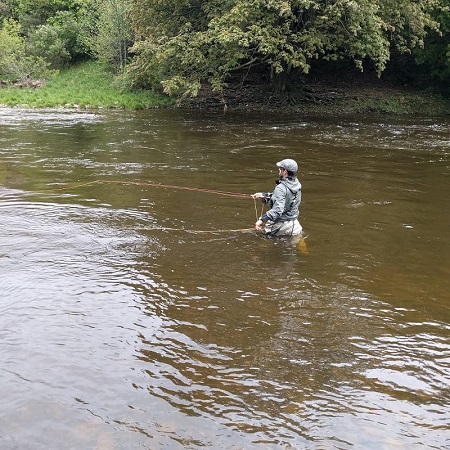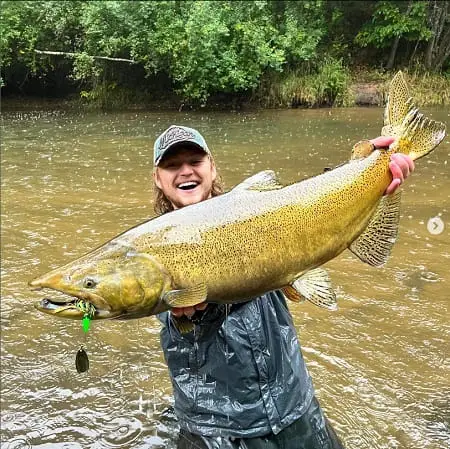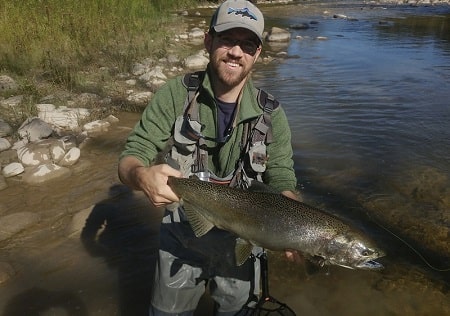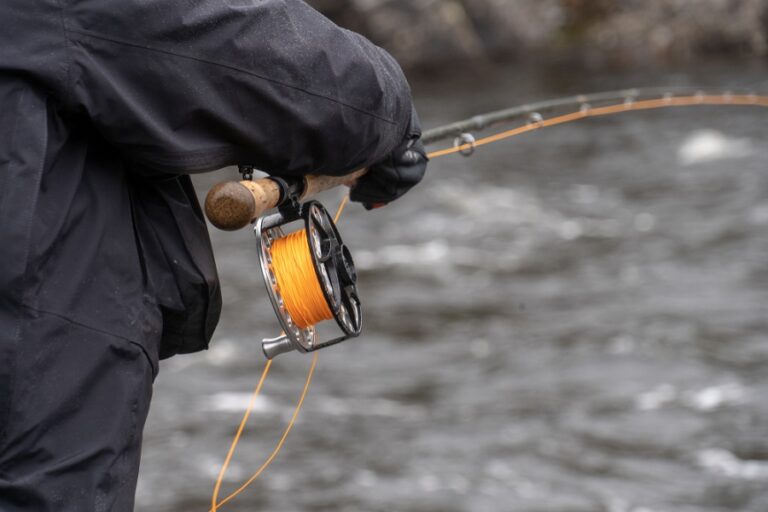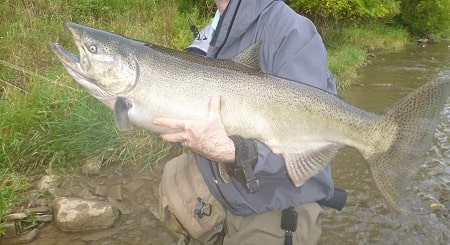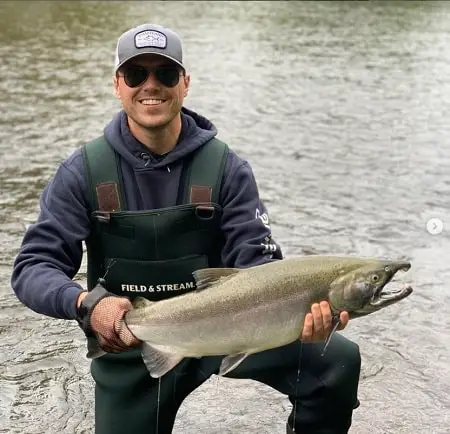Safety Tips For Fishing Near Bears When River Fishing
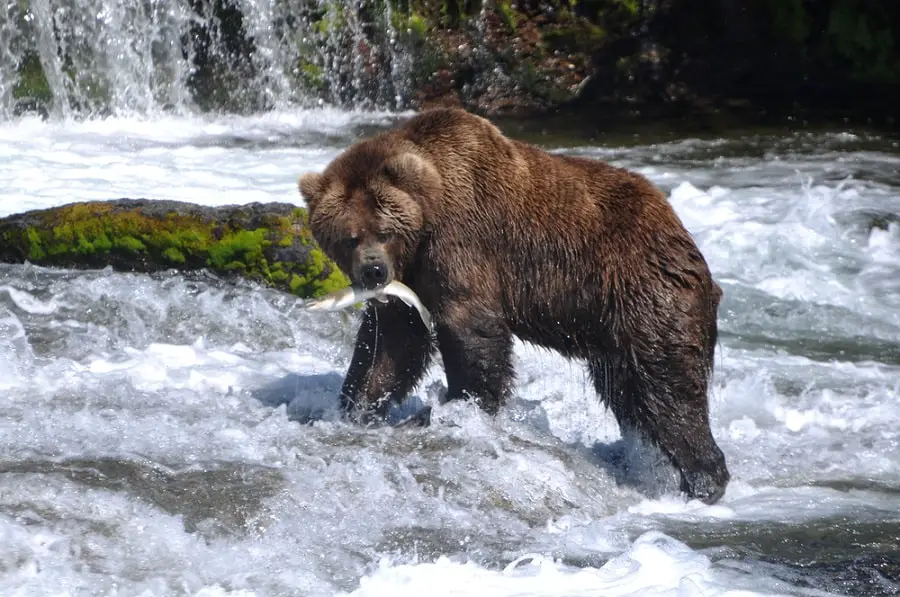
This article started out as safety tips for fishing for salmon fishing near bears, but there are times when you will be fishing rivers for steelhead and trout, and you will be fishing near bears, so you will need to be aware and prepared for an unexpected encounter.
Engaging with the Wilderness: Fishing Near Bears
Fishing amidst the lush wilderness of Alaska or in other Northern states and in Canada offers not only a rich bounty of fish but also an exhilarating experience, especially when in the company of the region’s majestic inhabitants – bears.
While the thrill of angling in such pristine environments is unmatched, it is paramount that anglers are well-versed with the essentials of bear safety and coexistence. This guide aims to navigate you through the vital aspects of ensuring a safe and enjoyable fishing expedition in bear country.
Key Takeaways for Safe Fishing Near Bears
- Always Be Bear Aware: Regularly scan your surroundings and look for signs of bears such as tracks or scat.
- Preparation is Crucial: Ensure you have bear spray accessible and know how to use it effectively.
- Handle Fish Wisely: Be mindful of how you handle fish and dispose of fish waste to avoid attracting bears.
- Maintain a Safe Distance: Never approach a bear and always retreat calmly without turning your back if encountered.
- Group Fishing is Safer: Whenever possible, fish in groups to deter bear interactions.
Understanding Bear Behavior
If you are fishing in an area where bears live, if you understand them and their behavior and know how to prevent an attack or stop an attack, you can be much better off.
Recognizing Bear Presence: Signs and Indicators
Awareness is your first line of defense when fishing in territories shared with bears.
Being able to identify signs of bear presence, such as fresh tracks, scat, and disturbed vegetation, can alert you to their proximity, enabling you to take precautionary measures. It’s crucial to be vigilant, especially in areas with dense foliage or loud river noises that might mask a bear’s approach.
Decoding Bear Actions: What Does a Bear’s Behavior Indicate?
Understanding bear behavior is pivotal in predicting their actions and ensuring your safety. Bears communicate through their body language, vocalizations, and actions. For instance, a bear standing on its hind legs might merely be trying to get a better view, while a swaying head and clacking teeth might indicate stress.
Familiarizing yourself with these bear behaviors and responding appropriately ensures that encounters remain non-confrontational.
Preparation and Precautions
There are things you can do to prevent a bad encounter or to prepare to protect yourself if an encounter should happen.
Essential Gear: The Imperative of Carrying Bear Spray
Equipping yourself with the right gear is a fundamental step towards ensuring safety during your fishing adventures amidst bears. Bear spray, a potent deterrent, has proven to be remarkably effective in warding off aggressive bears during unexpected encounters.
Ensure that your bear spray is EPA-approved, with a spray duration of at least 6 seconds and a minimum distance of 16 feet. Familiarize yourself with its operation and keep it readily accessible, not stowed away in your pack, to ensure immediate usage if needed.
Group Dynamics: The Safety in Numbers
Fishing in groups is not only a socially enriching experience but also a strategic one when in bear country. Bears are typically wary of larger numbers and are less likely to approach a group of anglers.
Ensure that your group stays close, maintaining a compact formation, especially in areas known for frequent bear activity. Communicate openly within your group, discussing plans, and establishing collective norms for bear safety to ensure unified actions during potential bear encounters.
Key Information on Bear-Safe Angling Practices
- Bear Spray Accessibility: Ensure bear spray is readily accessible and not stored in your pack.
- Group Cohesion: Maintain a compact group formation and establish collective bear safety norms.
- Respectful Distance: Avoid fishing in areas with visible bear activity and vacate spots that bears approach.
- Conscious Fish Handling: Bleed and clean fish responsibly, minimizing odors that attract bears.
Ethical Angling in Bear Territory
There are some things that anglers can and should do to co-exist and fish with the bears.
Respectful Fishing: Ensuring Bears and Anglers Coexist Peacefully
Ethical angling goes beyond the catch and release; it encompasses a holistic approach that considers the environment and its inhabitants. When fishing in bear habitats, it’s imperative to respect their space and routines.
Avoid fishing in areas where bears are visibly present or where there are signs of recent activity. If a bear is approaching your fishing spot, it is advisable to leave the area calmly, even if it means losing your catch.
Fish Handling: Minimizing Bear Attraction with Conscious Practices
Your practices regarding fish handling and disposal of fish waste are pivotal in minimizing bear attraction. Ensure that fish are bled in the water and consider cleaning them at a designated fish-cleaning station or at home.
If cleaning fish on-site, dispose of the waste in deep water, far from your fishing spot, to prevent bears from associating anglers with food availability.
Camping and Prolonged Stays
Secure Camping: Ensuring Your Stay Doesn’t Lure Bears
Establishing a secure camp is paramount when staying in bear country. Select a campsite at least 100 yards away from your fishing spot to minimize the chances of bears associating your camp with food sources.
Store food, cooking utensils, and any odorous items in bear-resistant containers and suspend them at least 10 feet above ground and 4 feet away from any vertical support. Always change into clean clothes before sleeping and store the clothes you cooked in away from your sleeping area.
Food and Waste Management: Averting Unwanted Bear Visits
Effective management of food and waste is crucial to avoid attracting bears to your campsite. Utilize bear-proof containers for storing food and never leave food unattended.
Dispose of waste in bear-proof bins and ensure that your campsite is immaculate after meals. Consider using a bear-resistant food storage locker to safeguard your provisions and deter bears from investigating your camp.
In Case of Bear Encounters
Stand, Don’t Run: Handling Sudden Bear Appearances
Encountering a bear can be an unnerving experience. It’s vital to remember that running may trigger a chase response. Instead, stand your ground, speak in a calm, assertive voice, and avoid direct eye contact, which bears may perceive as a threat.
Slowly back away without turning your back on the bear, and only turn around once you are at a safe distance.
Using Bear Spray: A Step-by-Step Guide
Bear spray should be your go-to deterrent in the event of a bear charge. Remove the safety clip, aim slightly downwards, and deploy a burst of spray when the bear is within 40 feet.
The objective is to create a barrier between you and the approaching bear. Be mindful of wind direction to prevent the spray from affecting you and always have a backup plan in case the spray is ineffective.
Final Takeaways for Bear Encounters and Camping
- No Running: Never run from a bear; instead, stand your ground and slowly back away without turning your back.
- Bear Spray Usage: Be proficient with bear spray usage and have a backup plan.
- Secure Camping: Choose campsites away from fishing spots and utilize bear-proof storage.
- Clean Campsite: Ensure meticulous cleanliness to avoid attracting bears to your camp.
Reflecting on Responsible Angling in Bear Habitats
Fishing amidst the wild terrains inhabited by bears is a privilege that comes with responsibilities. Ensuring your safety and that of the bears involves adhering to ethical practices, being prepared, and respecting the wildlife.
By embracing the guidelines outlined in this guide, anglers can contribute to fostering a harmonious coexistence with bears, safeguarding both parties and preserving the thrill of wilderness angling.
Additional Resources for Safe Fishing Adventures
For further insights into bear safety and ethical angling, consider exploring resources such as Bear Safety Courses and Wildlife Conservation Guides to enhance your knowledge and preparedness for future fishing adventures in bear country.
Final Thoughts
This comprehensive guide aims to equip anglers with the knowledge and practices to ensure safe and enjoyable fishing expeditions in bear-inhabited regions.
By respecting wildlife, adhering to ethical practices, and being prepared for potential encounters, anglers can immerse themselves in the thrill of wilderness fishing while safeguarding both themselves and the majestic bears that share their habitat.
Tight Lines,
Graham
Sources:
- U.S. National Park Service
- Comprehensive guidelines on bear encounters, avoiding them, and managing attacks, with additional resources on bear safety.
- Alaska Department of Fish and Game
- Tips on avoiding bear surprises, maintaining alertness, and proper food/garbage handling to prevent attracting bears.
- Wallowa-Whitman National Forest
- Advice on managing bear encounters with assertiveness and ensuring bears are not surprised by human presence.
- U.S. Fish & Wildlife Service
- Emphasizes maintaining a safe distance from bears and practicing ethical wildlife viewing without disturbing them.
- Alberta Parks
- Guidelines on bear awareness, including group travel, noise-making, bear spray usage, and managing bear encounters.

